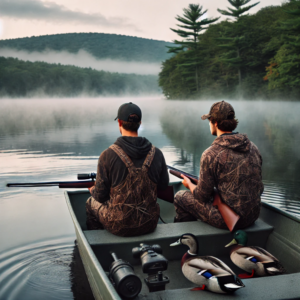Nestled in the heart of Pennsylvania, Lake Wallenpaupack is a gem that has captivated residents and visitors alike for generations. Stretching over 5,700 acres, this man-made hydropower lake not only provides recreational opportunities but also plays a vital role in energy production. Maintaining this balance between nature, recreation, and industry requires specialized expertise—expertise provided by foresters like Paul, a local with deep ties to the area.

Paul's story begins just a stone’s throw away from the lake itself. Growing up in the region, he attended Wallenpaupack High School, learned to swim in the lake’s cool waters, and even spent early mornings duck hunting before the school bell rang. These formative experiences fostered a lifelong connection to the land and water, making Paul uniquely suited for his role as a forester for the energy company that owns Lake Wallenpaupack.

A Forester’s Responsibilities
Foresters are often thought of as stewards of the land, and Paul’s work exemplifies this role. His primary responsibility is to manage and protect the forests surrounding the lake. These forests serve as a natural buffer, preventing soil erosion, improving water quality, and providing habitats for wildlife. For a hydropower lake like Wallenpaupack, maintaining the surrounding ecosystem is critical to ensuring the lake’s long-term sustainability.

Paul’s day-to-day tasks include:
- Forest Health Monitoring: Regularly inspecting trees for signs of disease, pests, or damage. Healthy forests are essential for reducing runoff and maintaining water clarity in the lake.
- Sustainable Harvesting: Overseeing selective logging operations to ensure they align with sustainable practices. This helps control tree populations, reduce fire risks, and provide raw materials without disrupting the ecosystem.
- Erosion Control: Implementing strategies to minimize soil erosion along the lake’s banks, such as planting vegetation, installing barriers, or designing runoff channels.
- Wildlife Management: Working closely with environmental scientists to monitor animal populations and ensure their habitats remain intact. This includes everything from deer to migratory birds, many of which rely on the lake’s ecosystem.
- Community Outreach: Educating local residents and visitors about conservation efforts. Paul often leads guided walks or hosts workshops, drawing on his personal experiences to connect with the community.
Balancing Industry and Environment
As an employee of the energy company, Paul also plays a pivotal role in aligning ecological preservation with the lake’s industrial purpose. Hydropower operations depend on consistent water levels and flow rates, which are influenced by the surrounding forested watershed. By managing this watershed, Paul ensures that the company’s operations remain efficient and environmentally responsible.
This balance requires careful planning and collaboration. For example, Paul works with engineers to identify areas where tree planting or removal could optimize water flow to turbines. He also coordinates with state and federal agencies to comply with environmental regulations and obtain necessary permits for forestry activities.
A Personal Connection
What sets Paul apart is his deep-rooted connection to Lake Wallenpaupack. Growing up in the area gave him an intimate understanding of its natural rhythms and cultural significance. He often recalls childhood summers spent fishing with his family or fall mornings paddling through misty waters in pursuit of ducks. These experiences have instilled a sense of responsibility and pride in his work.
Paul's local ties also make him a trusted figure within the community. Residents know him not just as a forester, but as a neighbor and friend who shares their love for the lake. This trust allows him to foster collaboration on conservation initiatives, whether it’s organizing shoreline cleanups or advocating for sustainable land use policies.
Challenges and Innovations
Managing the forests around Lake Wallenpaupack is not without its challenges. Invasive species, climate change, and increasing recreational use all pose threats to the ecosystem. Paul and his team tackle these issues head-on by leveraging innovative technologies and practices. GIS Mapping: Using geographic information systems to monitor forest conditions and track changes over time. This technology helps identify areas at risk of erosion or disease.
- Drones: Deploying drones to survey hard-to-reach areas, assess tree health, and detect signs of pest infestations.
- Community Science: Encouraging local residents to participate in citizen science programs, such as tracking bird migrations or reporting invasive plants.
The Legacy of Stewardship
Paul's work as a forester is more than just a job; it’s a continuation of a legacy. Lake Wallenpaupack has been a cornerstone of the community for nearly a century, and its future depends on careful stewardship. By blending his professional expertise with his personal connection to the area, Paul ensures that the lake remains a source of beauty, recreation, and energy for generations to come. As he walks through the forests he manages, Paul often reflects on the journey that brought him here. From a boy learning to swim in the lake’s inviting waters to a professional dedicated to its preservation, his story is a testament to the power of local roots and a passion for the natural world.
Conclusion
Lake Wallenpaupack is more than just a hydropower reservoir; it’s a living, breathing part of the community. Foresters like Paul play an indispensable role in maintaining this balance, ensuring that the lake continues to thrive both as an industrial asset and a cherished local treasure. Through sustainable forestry practices, innovative solutions, and a deep personal connection, Paul embodies the spirit of stewardship that is vital to the lake’s future.


